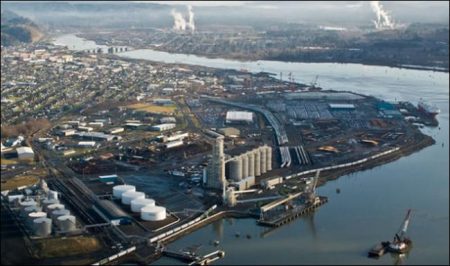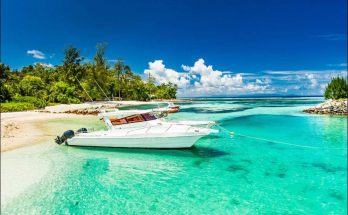The earliest recorded visit of an American to this part of the coast occurred in 1792, when Captain Robert Gray sailed his ship, the Columbia, over the bar and into the harbor which today bears his name. No attempt was made to establish a permanent settlement, however, until 1859. In that year James Karr and his family arrived and settled on the banks of one of the rivers flowing into the harbor.
Shortly thereafter he was joined by four brothers named Campbell. To the little settlement thus formed, and to the river on whose banks it stood, the name Hoquiam (Ind. hungry for wood), was given. Within the decade a number of other pioneers arrived, drawn by the promise of wealth in the virgin forests which stretched in an almost unbroken expanse from the Pacific Ocean to the Cascades. By 1869 a post office had become necessary, and in 1873 a school was opened.
In the meantime, some four miles to the east, a young Irishman, Samuel Benn, had staked a claim in 1867, at the juncture of the Chehalis and the Wishkah Rivers. Here he built a cabin, in which he lived alone until he was joined in 1875 by Alexander Young and James W. Stewart.
Three years later, George R. Hume, of Scotland, established a small fish cannery on Sam Benn’s Point. The cannery was named the Aberdeen Packing Plant, for Aberdeen, Scotland, home of some of the stockholders. This new venture and the rich natural resources of the region soon attracted a number of settlers, and the community they formed was named Aberdeen.
From the beginning, lumbering was the key to the growth and development of the Grays Harbor region. The greatest stand of Douglas fir ever found in the Pacific Northwest was located here. Famous timber tracts, such as the “21-9” (meaning Township 21, N., Range 9 W.), lay adjacent to the harbor; this one prodigious tract, 6 miles square, was logged for over 30 years. The towering trees of the region grew so compactly that they were invariably felled in one direction only, and at times the fallen trees were so crowded together that it was difficult to saw them into log lengths. Besides these splendid stands of fir, Sitka spruce and hemlock rose in great abundance, and some cedar was also to be found.
As soon as the means were developed to transfer this timber to market, lumbering in the region could go ahead at top speed. A trading connection between Grays Harbor and the Columbia River settlements was established in 1879 when the schooner, Kate and Ann, began to offer service between the two points. This was followed in quick succession by the beginning of logging operations on the lower Chehalis in 1881; the unloading of the first sawmill equipment on consignment to George H. Simpson in 1882; the construction of a mill and the platting of the townsite of Aberdeen in 1884; and of Hoquiam in 1885.
By the middle of the eighties, business and industry in the Grays Harbor settlements were sufficiently active and the population large enough to invite the publication of a newspaper. The Grays Harbor News was started in Hoquiam in 1885, followed in 1886 by the Aberdeen Herald, and in 1889 by the Aberdeen Weekly Bulletin (later the World) and the Washingtonian, another weekly, in Hoquiam. The completion of telegraph lines to the Harbor in 1890 gave the newspapers wire service. School facilities were provided, a hotel was built in Hoquiam in 1884, and a church in 1885. In 1890 a planked road was laid between the towns, presaging their united development.
Improvement in logging methods and in sawmill equipment speeded lumber production, making transportation an increasingly pressing problem. The Northern Pacific Railway had completed its line from Kalama to Puget Sound. Yet, despite their need for rail connections with broader markets, Hoquiam and Aberdeen failed to become the terminal of the Northern Pacific when Karr, founder of Hoquiam, proved unable to come to terms with the railroad for the sale of his holdings.
The Northern Pacific then built Ocosta, a few miles away on the south side of the harbor, as its terminal. To meet this situation, the citizens of Aberdeen, in 1895, bought and laid down the rails linking their mills with the Northern Pacific, thus gaining supremacy not only over Ocosta, whose development ceased, but over Hoquiam as well. In 1898, Hoquiam, after long negotiations, secured an extension of the railroad. In 1899 the first hull was launched from an Aberdeen shipyard.
In the early decades of the twentieth century, the national requirements for building materials increased; and, the Eastern forests having been in a large measure depleted, a growing demand arose for Western timber. Operators, needing more man power, started an advertising campaign to bring additional workers to the region. In response, loggers and mill hands came in large numbers, many from the woods of Wisconsin and Minnesota, others, Scandinavians and Finns, directly from their homelands. They were a hardy crew, these men who bore the hardships of the lumbering industry, and they brought new life to Aberdeen and Hoquiam.
The days of ox-team logging were over; and the introduction of the powerful donkey engine and the “high-lead,” or spar tree, to which great logs were jerked with taut steel cables, had brought logging to a high level of efficiency. With vast profits to be made, work was speeded ahead with little heed to accident prevention, timber breakage, or destruction of young growth. Men who worked in the woods needed rare courage and toughness.
Straining back against his safety belt, the “high rigger” walked casually up the side of a tall tree with an axe in his hand, stopped somewhere between 100 and 200 feet above the ground, braced himself at a sickening angle against the swaying trunk, and, with a flow of cheerful profanity, severed with deft strokes of his razor-edged axe the green plume that rose above him; the shock of the falling crest sent the trunk and the logger on it gyrating dizzily through the air. Men saw their companions mutilated or killed from time to time by snapping steel cables, falling timber, rolling logs, or whirling saws; and this unremitting danger was reflected in their speech and tales and in their Saturday night blowoffs in Hoquiarn and Aberdeen.
Usually, the men who worked in the forests remained wage earners, but sometimes one rose from the ranks of the loggers to become an operator. Alex Polson, who started as a member of a logging crew, emerged in time as one of the leading timber barons of the region. It was his crew that logged off the “21-9” forest of the Olympic peninsula. Polson personified the history of Pacific Coast lumbering, in every phase of which he participated.
Visits: 72



